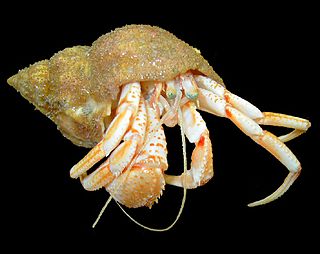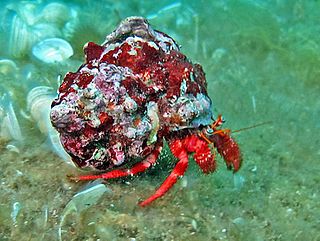
Gossypium is a genus of flowering plants in the tribe Gossypieae of the mallow family, Malvaceae from which cotton is harvested. It is native to tropical and subtropical regions of the Old and New Worlds. There are about 50 Gossypium species, making it the largest genus in the tribe Gossypieae, and new species continue to be discovered. The name of the genus is derived from the Arabic word goz, which refers to a soft substance.

The pathogenic fungus Cryphonectria parasitica is a member of the Ascomycota taxon. It is native to South East Asia and was introduced into Europe and North America in the 1900s. The fungus spread rapidly and caused significant tree loss in both regions.

The Apocrita are a suborder of insects in the order Hymenoptera. It includes wasps, bees, and ants, and consists of many families. It contains the most advanced hymenopterans and is distinguished from Symphyta by the narrow "waist" (petiole) formed between the first two segments of the actual abdomen; the first abdominal segment is fused to the thorax, and is called the propodeum. Therefore, it is general practice, when discussing the body of an apocritan in a technical sense, to refer to the mesosoma and metasoma rather than the "thorax" and "abdomen", respectively. The evolution of a constricted waist was an important adaption for the parasitoid lifestyle of the ancestral apocritan, allowing more maneuverability of the female's ovipositor. The ovipositor either extends freely or is retracted, and may be developed into a stinger for both defense and paralyzing prey. Larvae are legless and blind, and either feed inside a host or in a nest cell provisioned by their mothers.

Pagurus bernhardus is the common marine hermit crab of Europe's Atlantic coasts. It is sometimes referred to as the common hermit crab or soldier crab. Its carapace reaches 3.5 centimetres (1.4 in) long, and is found in both rocky and sandy areas, from the Arctic waters of Iceland, Svalbard and Russia as far south as southern Portugal, but its range does not extend as far as the Mediterranean Sea. It can be found in pools on the upper shore and at the mean tide level down to a depth of approximately 140 metres (460 ft), with smaller specimens generally found in rock pools around the middle shore and lower shore regions, with larger individuals at depth. P. bernhardus is an omnivorous detritivore that opportunistically scavenges for carrion, and which can also filter feed when necessary.
Parasitica is an obsolete, paraphyletic infraorder of Apocrita containing the parasitoid wasps. It includes all Apocrita except for the Aculeata.

The Evaniidae, also known as the ensign wasps, nightshade wasps or hatchet wasps, are a family of parasitic wasps. They number around 20 extant genera containing over 400 described species, and are found all over the world except in the polar regions. The larvae of these solitary wasps feed on cockroaches, and develop inside the egg-cases (oothecae) of their hosts.

The Batrachedridae are a small family of tiny moths. These are small, slender moths which rest with their wings wrapped tightly around their bodies.

Acraea esebria, the dusky acraea, is a butterfly of the family Nymphalidae from southern and eastern Africa.
Batrachedrodes is a genus of moths of the Momphidae family. All species of this genus are endemic to the Hawaiian Islands.
Batrachedrodes bedelliella is a moth of the family Momphidae. It was first described by Lord Walsingham in 1907. It is endemic to the Hawaiian islands. As of 1978, the distribution is not entirely clear. It is thought to be native to Oahu, Molokai, Maui and Hawaii, however only specimens from Maui and Molokai are certainly collected on those islands. The holotype was collected at Haleakala in Maui at 5,000 feet (1,500 m) elevation.
Batrachedrodes ephelus is a moth of the family Momphidae. It was first described by Lord Walsingham in 1907 and is endemic to the Hawaiian island of Molokai.
Batrachedrodes lomentella is a moth of the family Momphidae. It was first described by Lord Walsingham in 1907. It is endemic to the Hawaiian islands of Oahu and Hawaii.
Batrachedrodes sophroniella is a moth of the family Momphidae. It was first described by Lord Walsingham in 1907. It is endemic to the Hawaiian islands of Oahu, Maui and Hawaii.
Batrachedrodes supercincta is a moth of the family Momphidae. It was first described by Lord Walsingham in 1907. It is endemic to the Hawaiian island of Maui.
Stigmella ficivora is a moth of the family Nepticulidae. It was described by Gustafsson in 1985. It is endemic to Gambia where it is found only in one city called Bakau.

Calliactis parasitica is a species of sea anemone associated with hermit crabs. It lives in the eastern Atlantic Ocean and Mediterranean Sea at depths between the intertidal zone and 60 m (200 ft). It is up to 10 cm × 8 cm in size, with up to 700 tentacles, and is very variable in colour. The relationship between C. parasitica and the hermit crab is mutualistic: the sea anemone protects the hermit crab with its stings, and benefits from the food thrown up by the hermit crab's movements.

Acraea johnstoni, or Johnston's acraea, is a butterfly in the family Nymphalidae. It is found in southern Sudan, northern Uganda, Ethiopia, Kenya, Tanzania, Malawi, Zambia, western Mozambique and eastern Zimbabwe. The habitat consists of montane forests.

Acraea lycoa, the lycoa acraea, is a butterfly in the family Nymphalidae. It is found in Sierra Leone, Liberia, Ivory Coast, Ghana, Togo, Benin, Nigeria, Cameroon, Bioko, Angola, the Democratic Republic of the Congo, Sudan, Uganda, Rwanda, Burundi, Ethiopia, Kenya, Tanzania and Zambia. The habitat consists of forests.

Dardanus arrosor, the Red reef hermit or Mediterranean hermit crab, is a species of hermit crab.
Allantactis is a monotypic genus of sea anemones, and Allantactis parasitica is the only species in the genus. This sea anemone lives at bathyal depths in the North Atlantic Ocean and has a symbiotic relationship with a gastropod mollusc.










